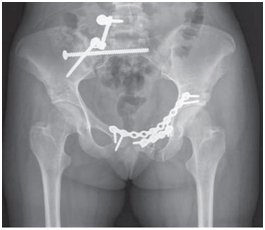Pelvic Acetabular Fractures

Most pelvic and acetabular fractures are caused by some type of traumatic, high-energy event, such as a car collision. Because the pelvis is in proximity to major blood vessels and organs, pelvic fractures may cause extensive bleeding and other injuries that require urgent treatment.
Acetabular fractures vary. For example, the bone can break straight across the socket or shatter into many pieces. When the acetabulum is fractured, the femoral head may no longer fit firmly into the socket, and the cartilage surface of both bones may be damaged.
If the joint remains irregular or unstable, ongoing cartilage damage to the surfaces may lead to arthritis.
Treatment for high-energy pelvic fractures and acetabular fractures usually involves surgery to reconstruct the pelvis and acetabulum to restore the hip stability so that patients can resume their daily activities.
Timing of surgery
Most acetabular fractures are not operated on right way. Your doctor may delay your surgery a few days to make sure your overall condition is stable and you are prepared for the procedure.
In some cases, an external fixator is used to stabilize the bones until healing is complete. In patients who are unable to tolerate a lengthy, more complicated procedure, an external fixator may be used as a temporary treatment until another procedure can be performed.

In this x-ray, an external fixator has been used to stabilize the pelvis
Open reduction and internal fixation.
During this operation, the displaced bone fragments are first repositioned (reduced) into their normal alignment. They are then held together with screws or metal plates attached to the outer surface of the bone.

In this x-ray, plates and screws have been used to repair a fractured pelvis.
It typically takes from 3 to 9 months for an acetabular fracture to completely heal. The outcomes of treatment will vary from patient to patient, depending on the following:
- Pattern and severity of the fracture
- Other injuries associated with the trauma
- Patient's age and bone quality
- Patient's general health, including smoking status. Research indicates that smoking can slow down bone healing and increase the risk for other complications
- Shoulder Replacement
- Rotator Cuff Repair
- Bankart's Repair
- Hil-Sachs Lesion Correction
- Knee Arthroplasty
- ACL Reconstruction
- PCL Reconstruction
- Meniscus Tear Repair
- Arthritis
- Knee Replacement
- Hip Replacement
- Ankle Replacement
- Regenerative Orthopedics
- Pelvic & Acetabular Fractures
- Neck & Back Pain Treatment
- Hand Surgeries
- Foot Surgeries
- Clubfoot Corrections
- General Orthopedic Trauma

Dr. Paul Paramel Antony is a Senior Consultant Orthopedic Surgeon and Head of the Department of Orthopedics and Joint Reconstruction at MAJ Hospital, Edapally, Ernakulam. His service is also available at Keyhole Clinic, Palarivattom. He did his M.B.B.S at Alleppey Medical College and his MS in Orthopedics from Christian Medical college,Ludhiana. He did his fellowships from reputed universities in Germany.
